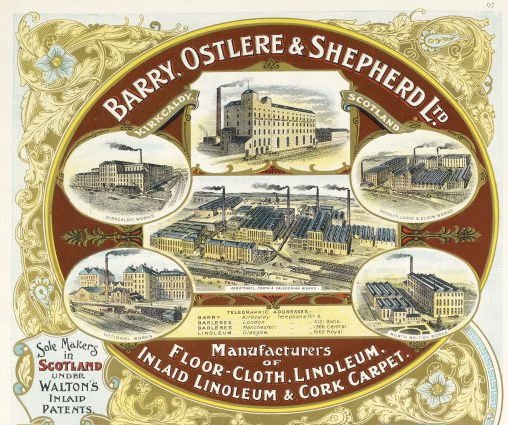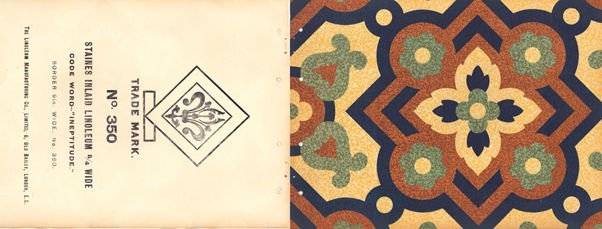January – the time of year when resolutions are made, goals and ambitions reviewed and plans put in place to make things happen, with the anticipatory excitement of a new decade, 2020. This year I’m taking up Amy Johnson’s challenge of 52 ancestors in 52 weeks, starting with a week 1 theme of a ‘fresh start’.

120 years ago, Alfred Palmer was on the cusp of a new chapter of his life. 1899 had been a tragic year for his family and with his nine children aged from 8 to 22, he left his job, family support network and familiar surroundings in the south of England to travel 500 miles north to set up home in Scotland.
I had always suspected that the move was driven by ambition and after years of research finding his obituary in the Barry Works magazine confirmed that in 1900 he left Egham in Surrey and moved to Kirkcaldy in Fife, Scotland to take charge of the Printing and Paint Departments at Barry, Ostlere and Shepherd’s linoleum factory.

© Courtesy of HES. Illustration from Scotland’s Industrial Souvenir, vol.2, 1905
Alfred was one of many Palmers and Jefferys to work in the floorcloth and linoleum industries. Painted canvas floorcloths were first introduced into English country houses in the 18th century as hard-wearing floor coverings and remained popular until the early 20th century when they were replaced by a new product – linoleum. Clusters of factories sprung up in the East End of London, Staines, Lancaster, and Kirkcaldy. Production required a skilled workforce including artisans to design and produce the increasingly intricate patterns.
Alfred Palmer was born on the 25th of November 1854, son of blacksmith William Palmer and his wife (Margaret) Jane Tate. Along with his sister Ann and brother Francis he was baptised at St Mary’s Parish Church, Battersea on the 11th August 1861.
We know from the census that Alfred and his family lived at 1 Somerset Street in Battersea in April of that year. By April 1871 Alfred’s father was dead his mother had married William Haddock and Alfred with his siblings and step-sisters lived at 25 Elfin Road, Kennington.
Alfred started work at Rolls and Son Floorcloth Works, Lower Kennington Lane, Bermondsey Road as a floorcloth painter. James Rolls entry in the 1843 London Post Office directory described the company rather grandly as “floor cloth & table cotton manufacturer, oil cloth painter & japanner of silk & linen, late of the Canal Bridge, Old Kent Road”.
In 1863 Frederick Walton patented an innovative new material – linoleum, created by processing linseed oil, resin, wood flour and additives onto a canvas backing. In 1864 Walton moved his factory from Chiswick to Staines and established the Linoleum Manufacturing Company.

Image from Linoleum Manufacturing Company, Ltd. 1902 Design Catalogue
In 1875 Alfred Palmer moved to Staines and a year later he married Ellen Selina Jeffery on the 27th December 1876 at the parish church of St John the Divine, Kennington. Ellen was the daughter of Joseph Jeffery and Sarah Reid, her sister Louisa was to marry Alfred’s brother William four years later.
By 1881 Alfred, his wife Ellen and their sons Alfred and Frank lived at George Street, Staines, Alfred was still employed as a floorcloth painter. By 1885 when three of their children were baptised, the family had moved 6 Woodham Place Staines (his brother William & sister-in-law Louisa lived at number 7).
When the next census was recorded in April 1891 Alfred, Ellen and their eight children: Alfred born 1878; Frank born 1880; Elsie born 1881; Frederick born 1883; Annie born 1886; Nellie born 1887; Arthur born 1889 and Rose born 1891 had moved to the neighbouring town of Egham and lived at Thorpe Road Villas.
As the 19th century drew to a close the family suffered tragedy. In 1898 their infant daughter Lena (Selina) died aged 2, Alfred’s wife Ellen died on the 7th March 1899, hours after giving birth to their youngest son Harold who subsequently died in August 1899 aged 6 months.
So, it was indeed a fresh start in 1900 when Alfred and his nine surviving children, the youngest Reginald aged only 8, headed north to take charge of the Printing and Paint Departments at Barry, Ostlere & Shepherd. (The factories were connected and in 1929 The Linoleum Manufacturing Company, Staines merged with Barry Ostlere and Shepherd and continued trading under the name of Barry and Staines Linoleum Limited).
When the census was recorded in March 1901 the Palmer family lived at 11 Novar Crescent, Kirkcaldy and he was now a foreman colour matcher.

11 Novar Crescent, Kirkcaldy © M. Palmer
Four years later on the 6th May 1904, Alfred married his second wife, Catherine Elizabeth Allen in Abbotshall Established Church Manse, Kirkcaldy. Chelsea born Catherine was the daughter of James Allen and Jane Hammett. Alfred’s daughter Annie and Charles Montgomery were witnesses at his second marriage. Census records show a Charles Montgomery, born 1872 Wraysbury (near Staines), occupation Floorcloth designer. In 1881 he lived at Thorpe Road, Egham and in 1891 in Hale Street Staines, by 1901 he was married and lived at 5 Munro Street Kirkcaldy. So perhaps Charles and Alfred moved to Scotland together. Alfred and Catherine had two daughters, Gladys born in 1905 and Mabel born in 1910. From 27th February 1917 until his death in 1928 Alfred lived at 2 Whyte-Melville Street, Kirkcaldy.
Like so many fathers of this era, he saw his sons enlist, be wounded and suffer long term debilitating health conditions following their service in World War 1. His youngest son Reginald, a talented artist never returned, dying from his wounds on the 27th February 1917. Reginald like his father and brothers worked at Barry’s as a designer.
Alfred’s obituary in Barry’s works magazine described how his management of the Printing and Paint Departments led to the business benefitting “considerably under the guidance of his wide experience”.
The tribute continued “failing eyesight compelled him to give up work in 1924, and blindness became his lot to the end. Gentle in disposition he was highly esteemed and respected throughout the works”.
A fresh start …it certainly brought Alfred success in his own career and earned him the respect of his managers and fellow workers. His sons Alfred, Frank, Frederick and Reginald followed him into the industry and the business records for Barry’s held at Fife Archives include images of his son Frank, as foreman of “The last of the hand printers, Barry, Ostlere & Shepherd”. His son Arthur followed a different career and by 1943 was a director of Vickers-Armstrong Ltd. when he received a C.B.E. but therein lies a different story.
Sources:
Baptisms (PR) England, Battersea, Surrey. 25 November 1854 PALMER, Alfred. Entry No 1235 p.155
Census 1861 England. Battersea, Surrey ED1 Household Sch: 160. Piece 370. Folio 14. p.30
Census 1871 England. Lambeth, Surrey. ED 29 Household Sch No 47 Piece 679 Folio 100 p.679
Welsh, Jon. (2012) ‘Floor and Wall Coverings’. In: Zimring, Carl A., Rathje, William L., eds. Encyclopedia of Consumption and Waste: The Social Science of Garbage.
Official Catalogue of the Great Exhibition of the Works of Industry of All Nations 1851 Pub. Cambridge University Press. p101
Sarin, Sophie. History. http://www.sarinfloorcloths.com/historyoffloorcl.html
Marriages (PR) England & Wales, St John the Divine, Kennington, Surrey. 27 December 1876. PALMER, Alfred and JEFFERY, Ellen Selina. p.20. Entry no.40. Collection: London England Marriages and Banns 1754-1921.
Obituaries. (1928) Barry’s Magazine. June. PALMER, Alfred. Vol. 2. No. 1. p. 13. Kirkcaldy Local & Family History Room, Kirkcaldy Galleries, Kirkcaldy, Fife.
Copyright © 2023. All rights reserved.